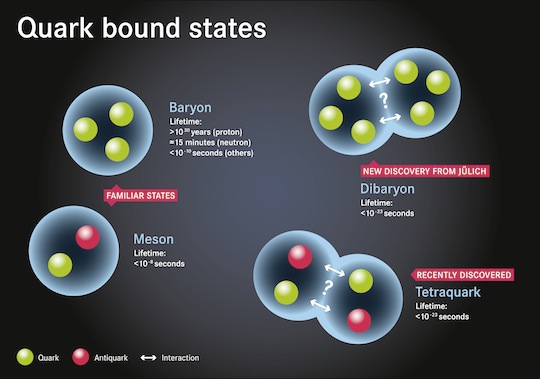This article is more than 1 year old
Massive news in the micro-world: a hexaquark particle
'Didn't you hear, I come in six-packs?'*
A German research synchrotron is trumpeting its find of a new exotic particle with six quarks – the largest quark number ever observed.
The "dibaryon" (two baryons) is described in a paper in Physical Review Letters (abstract here, pre-print version here at Arxiv).
If you're like this Vulture South hack, the paper reads as a very dry means of announcing a momentous discovery. For example: “The obtained Αγ angular distributions deviate systematically from the current SAID SP07 NN partial-wave solution. Incorporating the new Ay data into the SAID analysis produces a pole in the 3D3 – 3G3 waves in support of the d∗ resonance hypothesis.”
But it's the “3D3 – 3G3 waves” that matter here (we think), since it indicates the number of quarks the experiment observed.
The Jülich Research Centre press release notes that this is a confirmation experiment of results first observed in 2011. The previous experiment, however, wasn't able to be replicated by other researchers, so the operators of the COSY accelerator created a new experiment that others can reproduce.

Different states of quark matter. Image: Jülich Research Centre
“The measurements that we performed at COSY in 2011 were already very precise. But because the experiments could not be repeated at any other accelerator worldwide, we had to come up with another experiment to verify the results,” explains Professor Hans Ströher, director at the Nuclear Physics Institute (IKP-2) in Jülich.
The most familiar quark state in the universe is the baryonic state: three quarks bound to make up protons (which last forever), neutrons (which need the warm embrace of an atom to last longer than 15 minutes), and other baryons that decay in 10-10 seconds. Mesons, comprising a quark and an antiquark, also have a short life (10-8) seconds.
Theorists had predicted higher quark states for decades: Freeman Dyson is attributed as the first to suggest so, in 1964 – and the “tetraquark” that comprises two quarks and two antiquarks has been inferred from observations since 2003.
The new Jülich research doesn't observe the hexaquark directly: rather, the experiment watches for the decay products of the short-lived particle.
In this experiment, referred to as “elastic scattering”, the researchers bombarded a proton with deuterons. “The exotic bound state formed during the collision influenced the angle with which the particles moved away from each other after the collision, thus allowing it to be identified,” the research centre release states.
“The findings are part of a bigger picture. If this particle exists, then theoretically a whole range of other exotic states can be expected,” says Jülich’s IKP-1 director professor James Ritman.
El Reg notes that this piece of exotic particle physics didn't need the might and power of the Large Hadron Collider at CERN: COSY is a 184-metre synchrotron operating in the “medium” power range. ®
*Bootnote: As in "No, just a Zaphod Beeblebrox, didn't you hear I come in six packs?" ®
